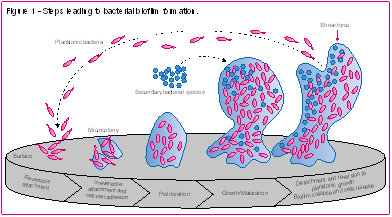FRANCK FOULON
GLOBAL PRODUCT MANAGER HYGIENE, HUVEPHARMA
One common survival strategy used by bacteria is to form biofilms. These communities and their inherent resistance to antimicrobial agents are at the root of recurrent bacterial infections in livestock rearing.
Bacteria have adapted to a “biofilmed” state to sur-vive unfavourable environmental conditions such as those which are poorly oxygenated, have extremes in temperature or are lacking in nutrients. In the natural environment, biofilms act as a reservoir for microbial species, constitute a major component of the bacterial bio-mass and guarantee ecological balance. But in livestock buildings, they are a source of permanent contamination that is particularly difficult to eliminate.
A livestock rearing house is a closed space with a dynamic mi-crobial ecosystem due to the high concentrations of organic matter, high temperatures and high humidity levels. The characteristics of this microbial ecosystem are determined by the microbiota of each animal and that of the herd. Animal excrement regularly enriches the microbiota of the building, especially with strains of enterococcus, coliforms, tract of the animals. The presence of animals in the barn caus-ent air. This warm air rises to the top of the building, carrying with it many micro-organisms in the form of bioaerosols. Thus, all surfaces of the building become contaminated and biofilms are formed (see Figure 1).

Biofilms are complex structures, constituting a considerable bacterial reserve in livestock buildings. They are formed on surfaces through the accumulation of stacked bacteria which secrete a protective polysaccharide or extracellular polymeric substances (EPS) during the maturation phase. This mucous matrix is excreted through a network of channels in which the medium can circulate.
The thickness of the biofilm does not increase indefinitely. Large aggregates or single cells may detach from mature bio-film and can directly seed other surfaces. The detachment of parts of the biofilm is partly due to variations in temperature and humidity inside the buildings. This contributes to air- borne bacterial spread, causing increased infectious pressure and new animal contaminations (see Figure 2).
The structures forming biofilms contain channels in which nutrients can circulate, and cells in different regions of a biofilm exhibit different gene expressions. The biofilm is therefore a mosaic of micro-niches containing different species but also different phenotypes of the same bacterial species. The cohesion of this microbial community relieson synergistic interactions and homeostatic mechanisms. The complexity of biofilm structure and metabolism has led to the analogy of biofilms to tissues of higher organisms eukaryotes), highlighting their remarkable evolutionary importance. Bacteria in a biofilm can be 1,000 times more resistant than individual bacteria. They acquire increased resistance to antimicrobial agents in two main ways:
1) Physico-chemical resistance
is the failure of an agent to penetrate the full depth of thebiofilm. Polymeric substances like those that make up the matrix of a biofilm are well known to retard the diffusion of antibiotics or disinfectants.
2) Extra-chromosomal resistance
Bacterial resistance to disinfectants is higher when bacteria are in biofilms, due to the acquisition of specific resistance genes carried by plasmids (circular periplasmic chromo-somes). In a biofilm, the plasmids are transferable between bacteria by intercellular bridges. Thus, the acquired resistance can be quickly spread to all bacterial species via horizontal transfer.
Numerous bacterial species and genera that cause infections in animals, and which may or may not have zoonotic potential, can form biofilms. Some examples are:
- Salmonella
- Campylobacter
- Escherichia coli
- Pseudomonas
- Staphylococcus
- Streptococcus
Biofilms increase infectious pressure and bacterial resistance to antibiotics, disinfectants and the immune response of the host. In animal husbandry, contamination of surfaces, air conditioning, ventilation and water distribution system with bio-films is a huge problem. But several of these bacterial species also have an impact downstream in food industries because of their ability to cause infections or food poisoning in humans.
Biofilms are therefore a constant threat to biosecurity because of their ability to diffuse into the environment and colonise all kinds of media. Their resistance to extreme conditions, including disinfection procedures, only makes matters worse.
Trying to disinfect without breaking biofilms is useless, and the best and most economical way to break the biofilm is to use detergents. Before the disinfection step, it is imperative to carry out a cleaning step with a detergent to dissolve and eliminate both the visible organic deposits and most of the EPS of the biofilm.
Adherence to this procedure and to general biosecurity management rules guarantees increased effectiveness of the disinfectant and suitable decreasing contamination of the surfaces before placing a new flock or herd in the building.
Huvepharma, through its expertise in biosecurity and animal health, provides a range of detergents and disinfectants to eliminate biofilms.